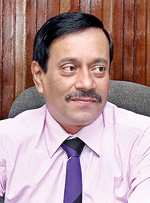News
10-hour shifts to produce ballot papers
View(s):Ballot papers for all 22 districts were printed and dispatched this week amid tight security, Government Printer W.A.A.G. Fonseka said. Election Department officials supervised the handover of ballot papers to an official of each District Secretariat.
“We started to print ballot papers from July 15 for 10 hours at a stretch every day and managed to finish printing on Monday,” Mr. Fonseka said.

Government Printer W.A.A.G. Fonseka
The entire printing and packing process was monitored via CCTV cameras while officials of the Elections Department were present as monitors at the Government Press and police provided security outside the premises. Every worker was checked when entering the press and was not allowed to bring any stationery into the building.
“Despite claims by politicians that forged ballot papers are used at elections this is not possible as special imported paper is used for printing the ballot papers. The papers are printed on paper that has a watermark as well as small fluorescent fibre that is illuminated under UV light,” Mr. Fonseka explained.
The imported paper was sealed when brought into the country and only unsealed in the printing area in front of officials of the department. An official checked every 1,000 ballot papers to make sure that the printing was accurate. Mr. Fonseka explained that although the required number of ballot papers was 15,044,490, his office had to print around 16,500,000 papers because the papers come in books of 50 ballot papers each and sometimes a new book had to be broken open to accommodate just a few voters with the rest of the book going unused.
Mr. Fonseka said 1,800,000 ballot papers – the highest number – had been printed for Gampaha District. Colombo, Kurunegala and Kalutara districts had the next highest amounts while the Vanni district had the lowest, 285,000. The Colombo District ballot papers are about 25 inches long to accommodate the longest list of candidates.
Mr. Fonseka said polling lists had been printed and given to the Elections Department. In all, the election material from the Government Printer cost about Rs 3.6 million. The ballot papers consumed 90 metric tonnes of paper.

